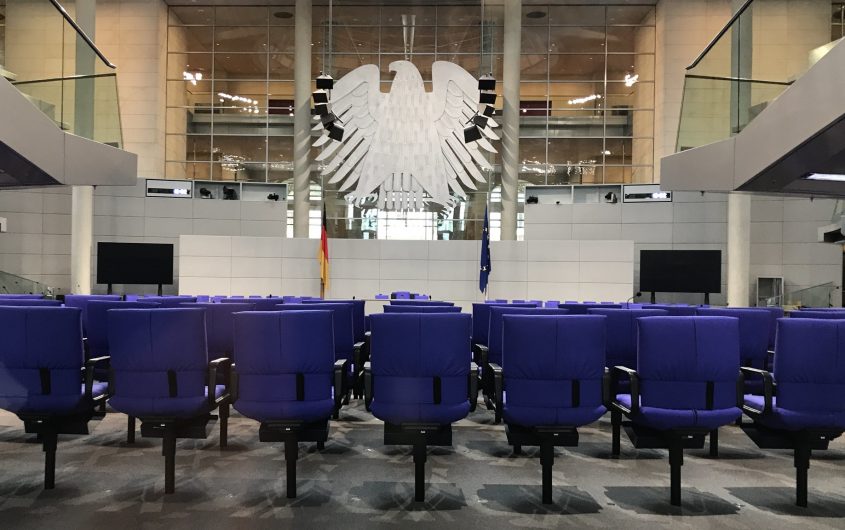
David McKelvey via Flickr
2021 German Bundestag Election: Three Messages

Jörn Quitzau
Berenberg Bank
Joern Quitzau is a Geoeconomics Non-Resident Senior Fellow at AICGS. He is a Senior Economist at Berenberg, Germany’s oldest owner-managed private bank. In addition, he is a lecturer at Frankfurt School of Finance & Management. He specializes in economic trend research and economic policy and has been working on several aspects of the European integration for more than ten years.
Prior to his position at Berenberg, Joern Quitzau worked for Deutsche Bank Research in Frankfurt (2000-2006) with a special focus on tax and fiscal policy.
Dr. Quitzau (PhD, University of Hamburg) was a Visiting Fellow at AICGS in April 2014 and an American-German Situation Room Fellow in April 2018.
The results of the German Bundestag Election leave open several questions. A total of six parties are entering the Bundestag. How can a governing coalition be formed in this fragmented party landscape? The contours are beginning to emerge.
Nevertheless, forming a coalition is a tough job. In every conceivable constellation, two parties, whose election programs and ideologies do not quite fit together, will have to cooperate.
Regardless of this, however, the election results send three interesting messages:
- The downward trend of the People’s Parties continues.
- Radical left-wing policies do not have majority support.
- A strong state is en vogue.
1. Downward trend of the mainstream parties
In the 1970s, the two People’s Parties, the Christian Democratic Union/Christian Social Union (CDU/CSU) and the Social Democrats (SPD), received over 90 percent of the electoral votes. The Free Democratic Party (FDP) was the third party to be represented in the Bundestag. It was the only possible coalition partner for the People’s Parties. All other groups were merely splinter parties, which together received just under 1 percent of all votes. Since the 1970s, the approval ratings for the CDU/CSU and SPD have clearly been trending downward (see figure). Although the SPD improved its election result by a good five percentage points compared with 2017, the CDU/CSU lost almost nine percentage points. All in all, the two parties once again posted a historically poor election result. Together, they no longer even achieved 50 percent of the votes.
How can the dramatic loss of importance of the once so large and dominant parties be explained? Leaving aside all personal and party political mistakes, there is an obvious explanation: The party landscape is a reflection of society. What was once a comparatively closed and homogeneous society has become more diverse and fragmented in recent decades. It would be a miracle if such a heterogeneous society could be satisfied with the political offerings of just two major parties. The range of parties has expanded accordingly: The Green Party, founded in 1980 and first represented in the Bundestag in 1983, is a left-wing liberal party with a strong ecological orientation. The Left Party is even further to the left on the political spectrum, a relic from the times of the German Democratic Republic (GDR), it emerged from the Party of Democratic Socialism (PDS), the successor party to the East German Socialist Unity Party (SED). The Alternative for Germany (AfD) has established itself to the right of the CDU/CSU. It was founded in 2013 and initially saw itself as an alternative to the euro rescue policy of the CDU/CSU under Chancellor Angela Merkel. In the 2021 federal election, the Greens (14.8 percent), the Left Party (4.9 percent) and the AfD (10.3 percent) together made it to 30 percent, absorbing almost one third of the votes.

Source: Bundestag, Bundeswahlleiter
Compared to the United States, the political product range in Germany is thus considerably larger. The German voter has many more choices. Does this mean that the political preferences of citizens are also better served? Not necessarily. Despite the wide range of choices, the governing parties can ultimately only offer citizens “one size fits all” solutions. This is in the nature of things, because politics offers collective goods for which individual tailoring is not possible (or only possible to a very limited extent). In diverse societies, one-size-fits-all solutions automatically lead to frustration. In this sense, political tensions are the price to be paid for the fact that societies today are more open and heterogeneous. Similar developments can be observed in other European countries.
2. Voters do not want a sharp turn to the left
For a long time, it looked in the election polls as if the votes for the SPD, the Greens and the Left Party would be enough to form a red-red-green coalition. From an economic perspective, such a left-wing alliance would have been a real risk scenario, because the election programs of the three parties are peppered with concepts that would stifle growth. The “Agenda 2010” from Gerhard Schröder’s chancellorship would probably have been reversed in good part. Such a coalition would also have explosive effects on foreign policy, as the Left Party questions Germany’s NATO membership.
In the end, however, there was not enough support for the three parties. In particular, the Left Party, with its radical political approaches, received only a disappointing 4.9 percent of the vote. The Greens also fell far short of the results of their interim poll peak. Both results are surprising. The economic and sociopolitical debates had previously given the impression that the Zeitgeist was almost exclusively dominated by climate and wealth distribution issues. This assessment must obviously be more nuanced. Even though these issues are important, they are not as dominant as they often appear. It is also very surprising that the FDP was able to win the most votes among first-time voters. The Greens followed only in second place, despite the “Fridays for future” movement. Public opinion polls and the Zeitgeist are obviously not reliable indicators of current majority opinion. The role of social media and political activism would therefore need to be much better researched.
3. The strong state is booming
Even if the majority of German voters does not want a sharp turn to the left with a state that tends to overreach, the relationship between the market and the state will be rebalanced in the new legislative period. One thing should already be clear: the days when politics was on the defensive are over. Only the liberal (in the European sense) FDP still stands for a clear free-market orientation. In contrast, the strong state dominates the election programs of the SPD and the Greens.
The state has already celebrated a comeback in recent years with an active economic policy. This is not only true for Germany, it is an international phenomenon.
There are two main reasons for the stronger role of the state:
- In recent years, there have been several issues that could not be solved by the private sector alone. Government actions are required. This was particularly evident during the pandemic. The United States came under much greater political pressure to act than in Europe because of the lack of welfare state protections. With the economic policy of President Biden, the United States is edging closer to the European welfare state model.
- States were able to look for new areas of activity because interest rates are low. Oppressive interest burdens have largely ceased to be a limiting factor for the government sector.
As a result, the economic Zeitgeist has also turned in Germany. A more active economic policy now hardly meets any resistance. Even fiscal restraint is no longer uncontroversial in times of low interest rates. Important projects such as digitization and climate neutrality are to be financed on credit.
Outlook
The election results should hold a few positive messages for German-American relations: German politics could become more pragmatic in a three-party coalition. The coalition negotiations are already demanding solution-oriented pragmatism from the parties. In addition, it is certain that there will be no red-red-green government. In terms of foreign policy, it would be irritating if a governing party seriously sought Germany’s withdrawal from NATO. And in terms of economic policy, the stability-oriented German system of the social market economy is likely to remain something of a model for the Biden administration. A strictly anti-capitalist left-wing alliance would probably seem rather alienating and made cooperation more difficult.








